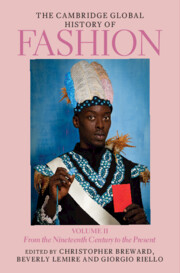Book contents
- The Cambridge Global History of Fashion
- The Cambridge Global History of Fashion
- The Cambridge Global History of Fashion
- Copyright page
- Contents for Volume II
- Figures for Volume II
- Maps for Volume II
- Table for Volume II
- Contributors for Volume II
- Preface
- Part IV Fashion, Modernism, and Modernity
- Part V Fashion, Colonialism, and Post-Colonialism
- 29 Chinese Coolie Hats
- 30 Crumbling Empires and Emerging Nations
- 31 Gender, Nation, Fashion, and Modernities in the Asia-Pacific, 1900 to the Present
- 32 The Global Politics of Wearing, Buying, and Selling European-Style Dress, c. 1900–1930
- 33 Fashioning Diasporas
- 34 Colonial Fashion Histories
- Part VI Fashion Systems and Globalization
- Index
- References
32 - The Global Politics of Wearing, Buying, and Selling European-Style Dress, c. 1900–1930
from Part V - Fashion, Colonialism, and Post-Colonialism
Published online by Cambridge University Press: 04 August 2023
- The Cambridge Global History of Fashion
- The Cambridge Global History of Fashion
- The Cambridge Global History of Fashion
- Copyright page
- Contents for Volume II
- Figures for Volume II
- Maps for Volume II
- Table for Volume II
- Contributors for Volume II
- Preface
- Part IV Fashion, Modernism, and Modernity
- Part V Fashion, Colonialism, and Post-Colonialism
- 29 Chinese Coolie Hats
- 30 Crumbling Empires and Emerging Nations
- 31 Gender, Nation, Fashion, and Modernities in the Asia-Pacific, 1900 to the Present
- 32 The Global Politics of Wearing, Buying, and Selling European-Style Dress, c. 1900–1930
- 33 Fashioning Diasporas
- 34 Colonial Fashion Histories
- Part VI Fashion Systems and Globalization
- Index
- References
Summary
On the urban streets of Cairo, Tokyo, or Mombasa, around 1900–1930s, clothing in multiple styles coexisted, including varied ‘European styles’, differently categorized in each location as part of local fashion culture: under full- or half-body covering veils, women in Cairo wore European-style dresses; next to groups of women in colourful kanga wrappers in Mombasa or meisen kimono in Tokyo, groups of working men wore uniform-like ‘Western’ business attire or simplified short-sleeved shirts and half-trousers.
Until recently, the adoption and diffusion of European-style clothing has been mainly discussed by region or group, mostly within the framework of national history.
- Type
- Chapter
- Information
- The Cambridge Global History of FashionFrom the Nineteenth Century to the Present, pp. 1123 - 1154Publisher: Cambridge University PressPrint publication year: 2023



